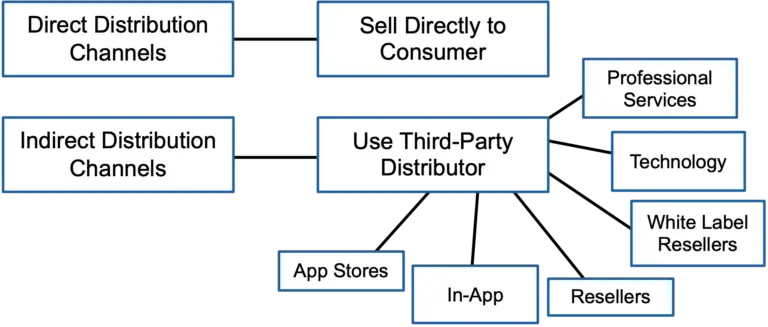What is an Indirect Distribution Channel?
You might be wondering what exactly is an indirect channel of distribution. If so, you’re in the right place as we will cover that topic and whole lot more. To begin, a distribution channel (sometimes known as a sales channel or marketing channel) refers to a means by which a company sells to customers. Direct distribution channels refer to a situation where the company’s own employees are directly interacting with and getting customers to buy its goods and services. An Indirect Distribution Channel or Indirect Marketing Channel refers to selling and marketing a company’s goods and services through a third party intermediary. In this way, the company is initially NOT in direct contact with the customer. The company’s employees reach customers indirectly through third parties.
In the context of a SaaS company I’ll be talking about indirect sales channels, or indirect distribution channels, for SaaS businesses. For SaaS startups, there are 6 types of indirect distribution and marketing channels available to reach customers. Lets discuss each type in detail and explain which channels are most useful in which types of situations.

The Six Types of Indirect Sales Distribution Channels
There are six different indirect distribution channel options for you to consider adopting in your business. We’ll start with the indirect sales channels for the lowest price points and move up to more complicated and more enterprise-level sales.
1. App Stores
The first is the app stores. If you have a small mobile app, send it through an app store like Google Play Store or Apple’s App Store. It’s a very simple way of getting people to buy your app. Typically, this is appropriate for price points under $10 or $15 — a $2 app, $4 app, and so on and so forth.
The advantage of this particular approach and channel is that these app stores have an enormous amount of traffic. There are people searching to get an app. By being in the store, you are findable, and you can sell more of your apps. The downside is that there are intermediary costs. They take a cut, which is the downside.
2. In-App Purchases
The second indirect channel is to use what I call “in-app purchases.” You are on the app store to get that initial sale, and sometimes, you offer the base product for free as a way to get it into users’ hands. They start using it, and as they encounter more advanced features that they want to use (because they’re in the middle of working on something), then they can buy those features within the app, and upgrade the capabilities of your app.
I distinguish this because, in the app store, it’s really the app store’s search engine that’s driving the traffic that gets you an audience, where you can then convince them to make a download. With in-app purchases, it’s the quality of your app that has drawn visitors directly to your app. Then, it is your promotional efforts within the app that set up the purchase as well as initiate the purchase process of buying an upgraded app from within the app itself. So that’s your second option.
3. Resellers
The third option for an indirect sales channel is resellers. A classic example of this is how Amazon resells Microsoft Office. They either sell a physical disk (as they have in the past), or more commonly, they sell a download code from Amazon.
In this particular case, when I buy Microsoft Office from Amazon, Amazon is the one that charges me, not Microsoft. So, that’s an example of using a reseller. You could have resellers at the low end, under $100. You could have something else that resells at thousands or tens of thousands of dollars as well. That’s the third option.
4. White Label Resellers
I’ve covered app stores, in-app purchases, and resellers. The fourth option is what I call “white label resellers.” That’s when you sell your technology to a third party that takes your technology, puts their branding, brand name, and logo all over that core technology, and resells it as their own. The customer doesn’t really realize that you are the underlying provider of that technology. They just realize they’re buying from a trusted source from which they’ve purchased often before.
So, that’s an example of using a white label reseller. Certain companies want to protect their brands. They like your technology, but they don’t want to introduce other parties into their customer relationship. For those kinds of partners, a white label relationship might make sense.
5. Other Technology Providers
Our fifth option is to incorporate and sell with other technology providers. In those situations, it’s very similar to a white label reseller relationship, where it is the partners’ identity and brand identity that’s driving the sale. But in an “other technology providers” type of distribution model, there’s usually integration rather than a straight-up resell.
They’re actually taking your technology, really tightly integrating it with their own, creating, essentially, a third offering that neither you nor they have independently, and then selling that to their customers under their logo. So, more technology integration and development efforts are required for this particular option.
6. Professional Services Firms
The sixth and final indirect distribution channel is using professional services firms. Professional services firms can facilitate or initiate a sale in a couple of different ways. This is typically more common in more expensive offerings starting in the tens of thousands or high tens of thousands of dollars — but more commonly hundreds of thousands, if not millions of dollars — in terms of the annual contract value. That’s where professional services firms tend to get more involved.
This can be done in a couple of different ways. You can sell alongside a professional services firm. Maybe a customer wants to buy your software, but the integration is way too much work for them to do in-house, and just buying the software is a very incomplete solution. A professional services firm will sell alongside you, and it’s a partner-assisted sale, for lack of a better term.
Therefore, the customer says, “Oh, you have a technology offering from your company and a services offering from somebody else. That combined solution looks really good. It’s very complete. I don’t have any open issues. I’m going to make that purchase.” That’s a partner-assisted sale.
Other times, partners will just buy your licenses and a number of seats from you wholesale. They’re going to buy 100 seats, 1,000 seats, or 5,000 seats, and then they’re going to wrap their services around your technology offering and sell what’s called “a managed service” to end customers.
You see the slide in Telco services. You see it a lot in accounting-based services, where there’s an accounting technology plus accountants who operate that technology to achieve a particular outcome for a customer.
Generally, the more complicated a particular problem is to solve, the larger the company that’s buying the software, the higher the price point, then the more often you have partners involved in the sale either to assist the sale or really to be a wholesaler in the middle, wrapping their services around your particular offering.
Which Indirect Distribution and Marketing Channel Is Best for Your Business?
I covered six different indirect sales channels, or indirect distribution channels.
The right choice depends an awful lot on your strategy. What are you trying to accomplish? Who are you trying to reach? What are your price points?
Every indirect channel has tradeoffs. They have different economics. They have different strengths. The key is to be super thoughtful about what you are trying to accomplish and be accepting of the tradeoffs involved in each particular choice.
I hope this guide helps. If you’d like to be notified about similar resources, fill out the form below. If you have any questions on indirect sales channels, please feel free to add a comment below and I’ll be happy to answer your questions.
Additional Resources
If you enjoyed this article, I recommend joining my email newsletter. You’ll be notified when I publish other articles and helpful guides for improving your SaaS business. Submit the form below to sign up. Also, use the email icon below to share this article with someone else who might find it useful.
If you’re the founder and CEO of a SaaS company looking for help in developing a distribution channel strategy, please Click Here for more info.
How to Scale and Grow a SaaS Business


Great insights on indirect distribution channels! I never realized how much they could enhance a SaaS company’s reach. The examples you provided were very helpful in illustrating the different approaches. Looking forward to implementing some of these strategies!
Great insights on indirect distribution channels for SaaS! I found the examples particularly helpful in illustrating how partnerships can expand reach. It’s a reminder of the importance of collaboration in today’s competitive landscape. Looking forward to implementing some of these strategies!